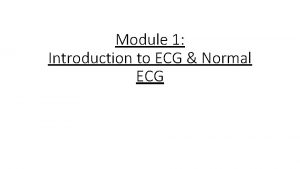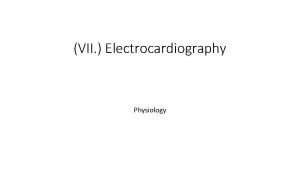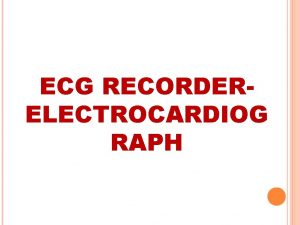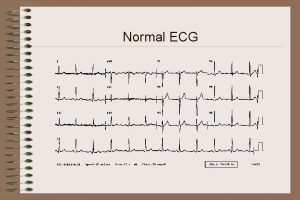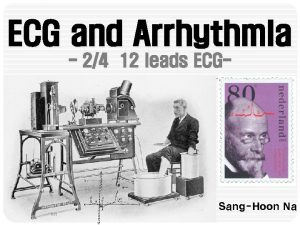The Normal ECG Normal P Wave Negative in






















- Slides: 22

The Normal ECG

Normal P Wave • Negative in a. VR • Positive in II • 2. 5 mm in amplitude • < 0. 12 sec. in width

Normal P Wave Normal direction of atrial depolarization a. VR? II? Figures 4 -2 and 4 -3

Abnormal P Wave Direction of atrial depolarization with junction rhythm This is an example of a retrograde conduction a. VR? II?


Normal QRS • Two phases • brief phase; depolarization of ventricular septum • longer phase; depolarization of both ventricles but the left is larger

First Phase • Depolarization of ventricular septum

Second Phase • Depolarization of both ventricles but the left is larger

Precordial Leads V 6 V 1

Normal QRS V 6? V 1? Fig. 4 -6 V 1? V 6?

Normal QRS V 1 V 6

Normal QRS • Septal r wave • Septal q wave

Normal R Wave Progression Transition Zone?

R Wave Progression Transition Zone?

Transition Zone • Figure 4 -7

Early Transition • Figure 4 -7

Delayed Transition • Figure 4 -7

Limb Leads • a. VR • predominately negative QRS and T • r. S, QS, or Qr pattern (Fig. 4 -9)

Limb Leads & Electrical Position • Electrical Position = Mean QRS Axis • horizontal QRS axis • vertical QRS axis • intermediate QRS axis

Horizontal Axis • I and a. VL show q. R • II, III and a. VF show r. S or RS • Figure 4 -10

Vertical Axis • a. VL (and sometimes I) show r. S or RS • II, III and a. VF show q. R • Figure 4 -11

Intermediate Axis • I, a. VL, III and a. VF can be predominately positive • Figure 4 -12
 Are there p waves in afib
Are there p waves in afib Rythme agonal ecg
Rythme agonal ecg J point on ecg
J point on ecg Chest leads vs limb leads
Chest leads vs limb leads Q wave ecg
Q wave ecg Ecg wave
Ecg wave How to measure pr interval
How to measure pr interval Normal.ecg intervals
Normal.ecg intervals Punto j ecg normal
Punto j ecg normal Normal ecg readings
Normal ecg readings Psvt ekg
Psvt ekg Ecg normal
Ecg normal Sound waves are electromagnetic waves true or false
Sound waves are electromagnetic waves true or false Carbon dioxide temperature
Carbon dioxide temperature Difference between full wave and half wave rectifier
Difference between full wave and half wave rectifier Compare and contrast transverse and longitudinal waves
Compare and contrast transverse and longitudinal waves Half wave rectifier meaning
Half wave rectifier meaning Full wave rectification
Full wave rectification P and s wave chart
P and s wave chart Full wave rectified sine wave fourier series
Full wave rectified sine wave fourier series A ____ is a repeating disturbance or movement that
A ____ is a repeating disturbance or movement that Wave wave repeating
Wave wave repeating Half wave symmetric signal
Half wave symmetric signal
